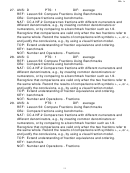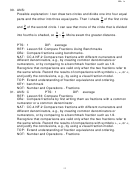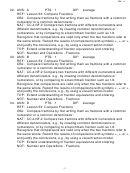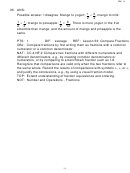Math Practice Test Page 23
ADVERTISEMENT
ID: A
20. ANS:
Possible answer: 6
and 4
; I found a common denominator of 2 and 3
12
12
that is greater than 8. Then I found equivalent fractions by multiplying 1
by
2
6
and 1
by 4
.
6
3
4
PTS: 1
DIF: average
REF: Lesson 50: Common Denominators
OBJ: Use equivalent fractions to represent a pair of fractions as fractions
with a common denominator.
NAT: CC.4.NF.1 Explain why a fraction a/b is equivalent to a fraction (n x
a)/(n x b) by using visual fraction models, with attention to how the number
and size of the parts differ even though the two fractions themselves are
the same size. Use the principle to recognize and generate equivalent
fractions.
TOP: Extend understanding of fraction equivalence and ordering.
KEY: multiple | common multiple | common denominator
NOT: Number and Operations - Fractions
21. ANS: A
PTS: 1
DIF: average
REF: Lesson 51: Problem Solving • Find Equivalent Fractions
OBJ: Use the strategy make a table to solve problems using equivalent
fractions.
NAT: CC.4.NF.1 Explain why a fraction a/b is equivalent to a fraction (n x
a)/(n x b) by using visual fraction models, with attention to how the number
and size of the parts differ even though the two fractions themselves are
the same size. Use the principle to recognize and generate equivalent
fractions.
TOP: Extend understanding of fraction equivalence and ordering.
KEY: equivalent fraction
NOT: Number and Operations - Fractions
8
ADVERTISEMENT
0 votes
Related Articles
Related forms
Related Categories
Parent category: Education
 1
1 2
2 3
3 4
4 5
5 6
6 7
7 8
8 9
9 10
10 11
11 12
12 13
13 14
14 15
15 16
16 17
17 18
18 19
19 20
20 21
21 22
22 23
23 24
24 25
25 26
26 27
27 28
28 29
29








